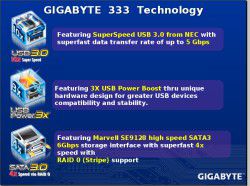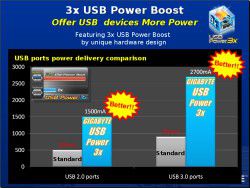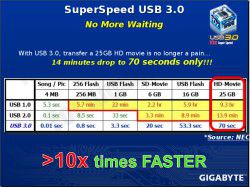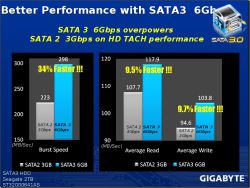From our front-page news:
Last week, Gigabyte held a press conference along with Marvell and Seagate to tout features with each of the respective company's new products. On the Seagate side, there was of course the Barracuda XT, the company's first drive to take advantage of the S-ATA 3.0 (6Gbp/s) spec. From Marvell was its SE9128 on-board chip, which is responsible for enabling S-ATA 3.0 on current Gigabyte motherboards that offer the support.
To coincide with the launch of both S-ATA 3.0 and USB 3.0, Gigabyte has relaunched a couple motherboards as revisions. To know if a board features these two technologies, you can simply look for the "A" addition in the model name. For example, the P55-UD6 becomes the P55A-UD6, and so on. Gigabyte calls the added technology on these boards the "333 Onboard Acceleration", where the "A" in "Acceleration" is the reason for the A in the model name.
The last of the three represents "USB Power 3x", which Gigabyte states is a unique feature at the current time. The 3x figure is literal, as in the slide below, you can see that the power output is indeed triple. The reason the company added this was because it will help negate the requirement of a power adapter for certain peripherals, such as external hard drives. It's really hard at this point to understand just how unique this particular feature is, but once such high-powered USB 3.0 devices hit the market, testing will need to be done. You can be sure that if this is indeed as useful as Gigabyte says it is, then other companies won't take long to follow.
<table border="0" align="center"> <tbody> <tr> <td> </td> <td>
</td> <td>
 </td> </tr> </tbody> </table> <table border="0" align="center"> <tbody> <tr> <td>
</td> </tr> </tbody> </table> <table border="0" align="center"> <tbody> <tr> <td>
 </td> <td>
</td> <td>
 </td> </tr> </tbody> </table>
</td> </tr> </tbody> </table>
Along with mentions of these technologies, Gigabyte included some light performance data as well, to help us gain a basic understanding of the improvements that can be seen. On the USB 3.0 front, and seen below, a massive 25GB HD movie would take only 70 seconds to transfer onto a perfect USB 3.0 storage device, down from 13.9 minutes on USB 2.0. Note that if this isn't theoretical, it's based on the best possible speeds out there, because 25GB in 70s equals 357MB/s, which current consumer SSDs can't even manage.
Of course, the presentation given wouldn't be complete without some S-ATA 3.0 benchmark results, and those are as we expected, "nice". The differences between S-ATA 2.0 and 3.0 aren't staggering on current-gen devices, but things should improve when even faster SSDs get out here, or HDDs with lower latencies. On a similar drive, a S-ATA 2.0 drive hit a burst speed of 223MB/s, while on S-ATA 3.0, the drive hit 298MB/s. We also see boosts of 9.5% on the average read and 9.7% on the average write. Again, not major, but certainly not worthy of complaint, either.
Motherboard vendor support for both S-ATA 3.0 and USB 3.0 has been great so far, so now it's just a matter of waiting for the respective devices to launch so we can take full advantage of what's given to us. It's kind of a weird situation to be in, because both of these technologies are so fast, that the products to take full advantage just don't seem to exist, at least not on the consumer side. Hopefully that means that USB 3.0 will enjoy a full life like USB 2.0 had.
Source: Gigabyte 333 Onboard Acceleration
To coincide with the launch of both S-ATA 3.0 and USB 3.0, Gigabyte has relaunched a couple motherboards as revisions. To know if a board features these two technologies, you can simply look for the "A" addition in the model name. For example, the P55-UD6 becomes the P55A-UD6, and so on. Gigabyte calls the added technology on these boards the "333 Onboard Acceleration", where the "A" in "Acceleration" is the reason for the A in the model name.
The last of the three represents "USB Power 3x", which Gigabyte states is a unique feature at the current time. The 3x figure is literal, as in the slide below, you can see that the power output is indeed triple. The reason the company added this was because it will help negate the requirement of a power adapter for certain peripherals, such as external hard drives. It's really hard at this point to understand just how unique this particular feature is, but once such high-powered USB 3.0 devices hit the market, testing will need to be done. You can be sure that if this is indeed as useful as Gigabyte says it is, then other companies won't take long to follow.
<table border="0" align="center"> <tbody> <tr> <td>
 </td> <td>
</td> <td>
 </td> </tr> </tbody> </table> <table border="0" align="center"> <tbody> <tr> <td>
</td> </tr> </tbody> </table> <table border="0" align="center"> <tbody> <tr> <td>
 </td> <td>
</td> <td>
 </td> </tr> </tbody> </table>
</td> </tr> </tbody> </table> Along with mentions of these technologies, Gigabyte included some light performance data as well, to help us gain a basic understanding of the improvements that can be seen. On the USB 3.0 front, and seen below, a massive 25GB HD movie would take only 70 seconds to transfer onto a perfect USB 3.0 storage device, down from 13.9 minutes on USB 2.0. Note that if this isn't theoretical, it's based on the best possible speeds out there, because 25GB in 70s equals 357MB/s, which current consumer SSDs can't even manage.
Of course, the presentation given wouldn't be complete without some S-ATA 3.0 benchmark results, and those are as we expected, "nice". The differences between S-ATA 2.0 and 3.0 aren't staggering on current-gen devices, but things should improve when even faster SSDs get out here, or HDDs with lower latencies. On a similar drive, a S-ATA 2.0 drive hit a burst speed of 223MB/s, while on S-ATA 3.0, the drive hit 298MB/s. We also see boosts of 9.5% on the average read and 9.7% on the average write. Again, not major, but certainly not worthy of complaint, either.
Motherboard vendor support for both S-ATA 3.0 and USB 3.0 has been great so far, so now it's just a matter of waiting for the respective devices to launch so we can take full advantage of what's given to us. It's kind of a weird situation to be in, because both of these technologies are so fast, that the products to take full advantage just don't seem to exist, at least not on the consumer side. Hopefully that means that USB 3.0 will enjoy a full life like USB 2.0 had.
Source: Gigabyte 333 Onboard Acceleration
